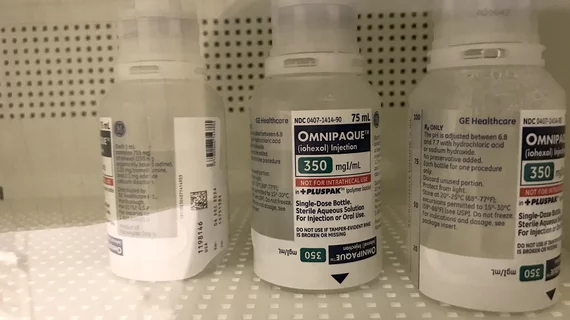Dose reduction protocol makes multiple same-day contrast injections possible when necessary
A new Practice Pearl published in the American Journal of Roentgenology details how one institution navigates the need for sequential contrast media injections during contrast-enhanced mammography-guided (CEM-guided) breast biopsies without raising the risk of kidney injury. [1]
At Banner University Medical Center in Phoenix, Arizona, a contrast reduction protocol is used when patients require multiple same-day injections.
“For patients undergoing CEM-guided biopsy of multiple enhancing targets, washout kinetics can degrade conspicuity of lesions not initially targeted for biopsy, necessitating sequential contrast media administrations,” corresponding author Michael F. Morris, MD, with the division of diagnostic imaging at Banner MD Anderson Cancer Center in Gilbert, Arizona, and colleagues explain. “Additionally, certain circumstances (e.g., a patient with limited transportation) may require sequential injections to accommodate both CEM and CEM-guided biopsy in one encounter.”
To protect patients from contrast-associated acute kidney injury, contrast volume is reduced by 33% per injection. So instead of using a standard dose of 1.5 mL/kg (maximum, 120 mL or 44.4 g iodine), a dose of 1.0 mL/kg (maximum, 80 mL or 29.6 g iodine) is administered, keeping the dose below manufacturer recommended thresholds.
When tested on a phantom, these amounts were found to yield acceptable visualization of lesions, the group notes.
The authors offered two examples of patients who underwent sequential same-day injections at the lower dose:
The first patient, who required biopsy of bilateral suspicious lesions, had a serum creatinine level of 0.6 mg/dL before the procedures; three days later, the level was nearly the same at 0.7 mg/dl.
The second patient completed a CEM exam using the standard contrast dose, before undergoing CEM-guided biopsy on the same day using the reduction protocol, for a cumulative volume of 200 mL or 74.0 g iodine. Their serum creatinine was 0.89 mg/dL before biopsy and 0.72 mg/dl one week later.
The authors acknowledge that caution is necessary when administering contrast to certain patients, especially those with any issues related to kidney function or kidney disease. However, they note that “studies do not support a relationship between CA-AKI and IV iodinated contrast media volume when administered within clinical dosing ranges, and guidelines do not recommend withholding sequential doses when clinically indicated.”
This reduction protocol allows for acceptable lesion visualization while also providing a cautionary cushion when the safety of sequential contrast injections is in question, the group suggests.

